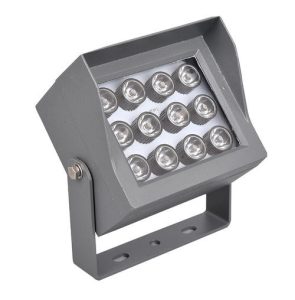Definition of Color Rendering Index
The color rendering ability of a light source to an object is called color rendering, which is compared with the appearance of the object under the same color temperature or reference light source (incandescent lamp or painting light). The spectral content emitted by the light determines the light color of the light source, but the same light color can be composed of many, a few or even only two monochromatic light waves, and the color rendering of each color is also very different. Light sources of the same light color have different spectral compositions, and light sources with a wider spectral composition are more likely to provide better color rendering quality.
When there is little or lack of the main wave reflected by the object under the reference light source in the light source spectrum, the color will produce obvious color shift. The greater the degree of chromatic aberration, the worse the color rendering of the light source. The color rendering index coefficient (Kau fman) is still a common method to define the color rendering of light sources.
Classification of Color Rendering Index
Faithful Color Rendering
A light source with a high color rendering index (Ra) must be used to correctly express the original color of the substance, and its value is close to 100, and the color rendering is the best.
Effect Color
To sharply emphasize a specific color, and express the beauty of life, you can use additive colors to enhance the color rendering effect. Using a low color temperature light source to illuminate can make the red more vivid; using a medium color temperature light source to illuminate, so that the blue has a cool feeling; using a high color temperature light source to illuminate, make the object feel cold.
The Relationship between Color Rendering Index and Color Rendering
When there is little or lack of the main wave reflected by the object under the reference light source in the light source spectrum, the color will have obvious chromatic aberration. The greater the degree of chromatic aberration, the worse the color rendering of the light source. The color rendering index coefficient (Kau fman) is still a common method to define the color rendering of a light source.
The color rendering index of sunlight is defined as 100, and the color rendering index of incandescent lamps is very close to sunlight, so it is regarded as an ideal reference light source. This system uses 8 standard color samples with medium chroma to test, compare the deviation degree of the 8 colors under the test light source and the same color temperature benchmark, to measure the color rendering index of the light source, and take the average deviation value Ra20-100 , 100 is the highest, the greater the average color difference, the lower the Ra value. Light sources below 20 are generally not suitable for general use.
Index (Ra) grade Color rendering General application
90-100 1A Excellent Places requiring precise color contrast
80—89 1B / Places that require correct color judgment
60—79 2 Ordinary Places requiring medium color rendering
40—59 3 / Places with low requirements for color rendering and small color difference
20—39 4 Poor Places with no specific requirements for color rendering
The theoretical color rendering index of incandescent lamps is 100, but there are many kinds of incandescent lamps in real life and their applications are different, so their Ra values are not completely the same, it can only be said to be close to 100, which is the lamp with the best color rendering. The color rendering index values of specific lamps can be seen in the table below.
Light source color rendering index Ra
Incandescent lamp 97
Daylight fluorescent lamp 80—94
White fluorescent lamp 75-85
Warm white fluorescent lamp 80-90
Tungsten halogen lamp 95—99
High-pressure mercury lamp 22—51
High pressure sodium lamp 20-30
Metal halide lamp 60-65
Sodium thallium indium lamp 60-65
Dysprosium lamp above 85
LED light 65~100
LED Color Temperature and Color Rendering Index
In the later stage of LED lighting equipment design, it is necessary to understand the color temperature of LEDs. Therefore, the knowledge related to LED color temperature has become one of the knowledge that every LED product designer must contact. Like the LED safety regulations, the color temperature of LEDs affects the marketing of products to a certain extent. The color temperature that meets the standard will provide the most comfortable lighting environment, thereby opening up the market.
This article will introduce the color temperature and color rendering index of white light LEDs to facilitate readers who have just stepped into LED design to accumulate basic knowledge.
For light source products such as white light LEDs whose luminous color is basically “white light”, the coordinates can accurately express the apparent color of the light source. But the specific value is difficult to associate with the accustomed feeling of light and color. People often refer to light colors that are more orange-red as “warm colors”, and those that are more blazing or slightly blue are “cool colors”. Therefore, it is more intuitive to use color temperature to express the light color of the light source.
When the luminous color of the light source is the same as the color radiated by the black body at a certain temperature, the temperature of the black body is called the color temperature (T) of the light source, and the unit is K. For white light LEDs, the luminous color is often not exactly the same as the chromaticity coordinates of the black body (complete radiator) at various temperatures, and the color temperature cannot be expressed at this time. In order to facilitate comparison, the concept of correlated color temperature (CCT) is adopted. That is, when the chromaticity of the light source is closest to the chromaticity of the complete radiator at a certain temperature, that is, when the chromaticity difference on the 1960 CIE-UCS chromaticity diagram is the smallest, then the temperature of the complete radiator is called the chromaticity of the light source Correlated color temperature R1.
LEDs used in lighting projects, especially white light LEDs, in addition to the color performance, the more important characteristics are often the color of the surrounding objects under the LED light and the color of the object under complete radiation (such as sunlight). Consistency, the so-called color rendering characteristics.
In 1974, CIE recommended the “test color” method to quantitatively evaluate the color rendering of a light source. It measures the total color shift of the standard sample under the illumination of the reference light source and under the illumination of the light source to be measured to specify the display of the light source to be measured. Color is expressed by a color rendering index value. CIE stipulates that a complete radiator or standard illuminator D is used as a reference light source, and its color rendering index is set to 100. It also stipulates a number of standard color samples for testing.
According to the color difference formed by the standard color sample under the reference light source and the light source to be measured, the color rendering of the light source to be measured is evaluated. The color rendering index of the light source for a certain standard color sample is called the special color rendering index R1.
R1=100-4.6△Ei (2-3)
In the formula, △Ei is the color difference between the ith standard color sample under the reference light source and the light source to be measured. The average color rendering index of the light source for the first 8 color samples is called the general color rendering index Ra.
There are 14 standard color samples recommended by CIE. No. 1-8 are commonly used representative hue samples with medium saturation and medium brightness. No. 9-14 samples include several saturated colors such as red, yellow, green, and blue, European and American skin colors, and leaf green. In 1985, China formulated the “Light Source Color Rendering Evaluation Method” standard, and added the color sample of Chinese female skin color as the fifteenth standard color sample.
Knowing these color rendering indexes actually has a subtle influence on LED lighting equipment, because in some special occasions, such as studios, shopping malls, beauty places, etc., different light will make the skin reflect different states, thereby affecting customers’ The final result of shopping or shooting.







